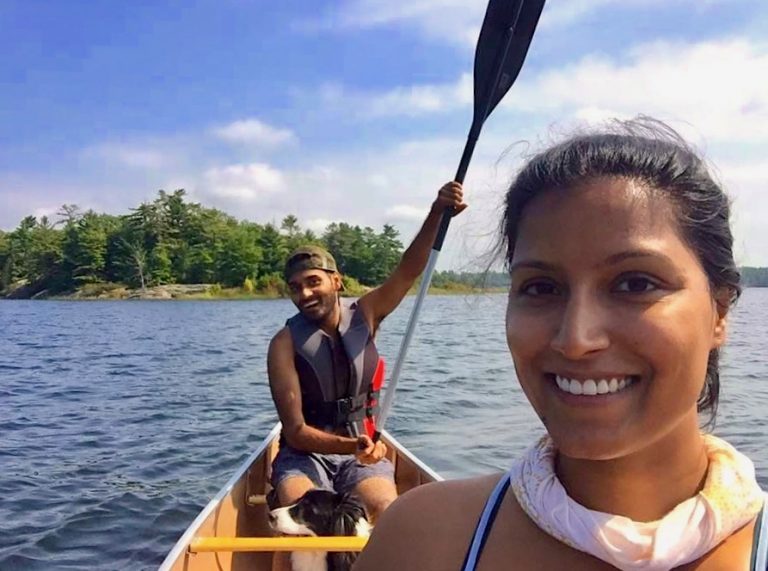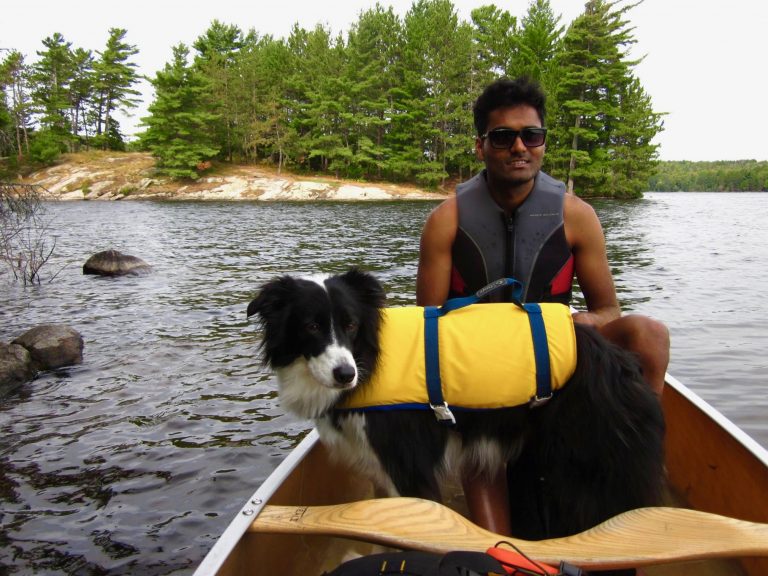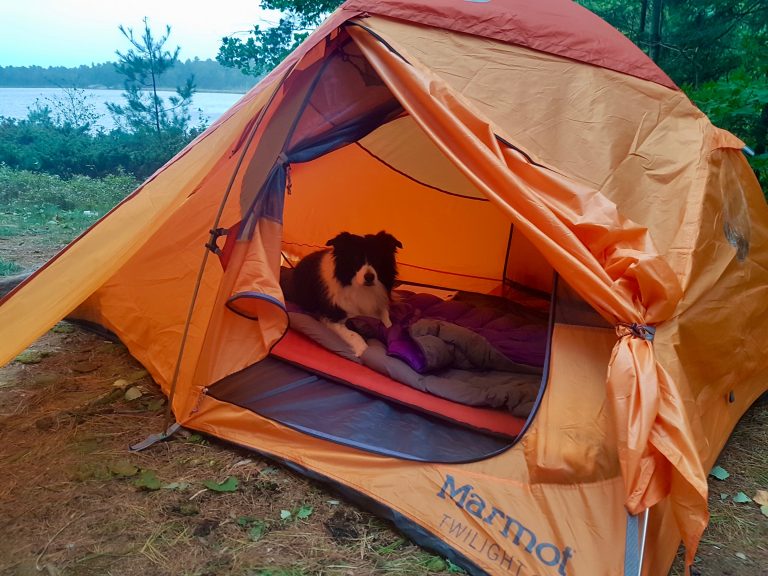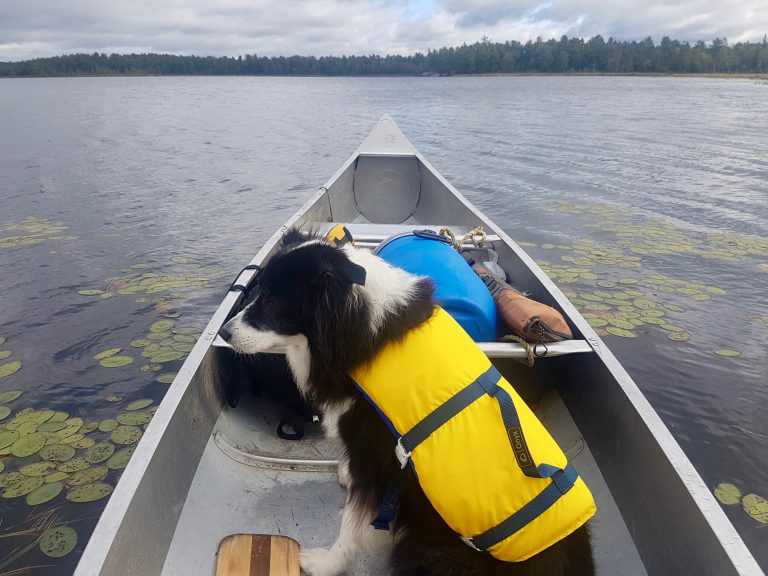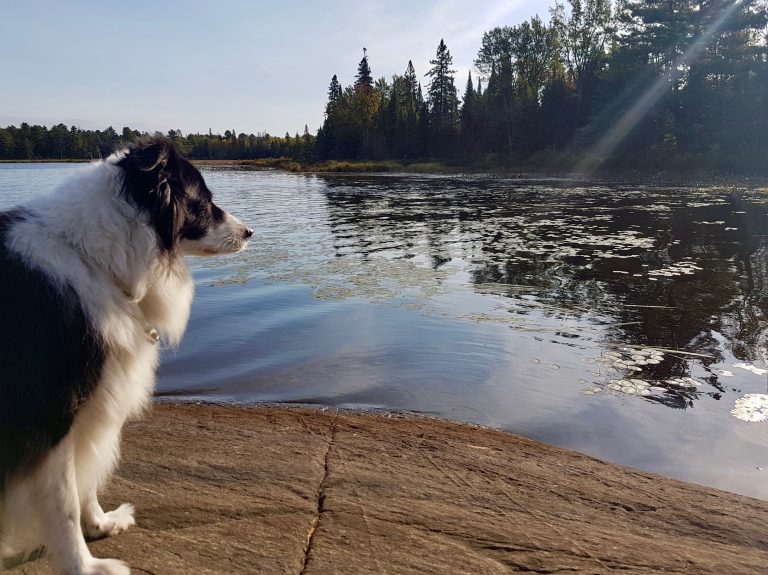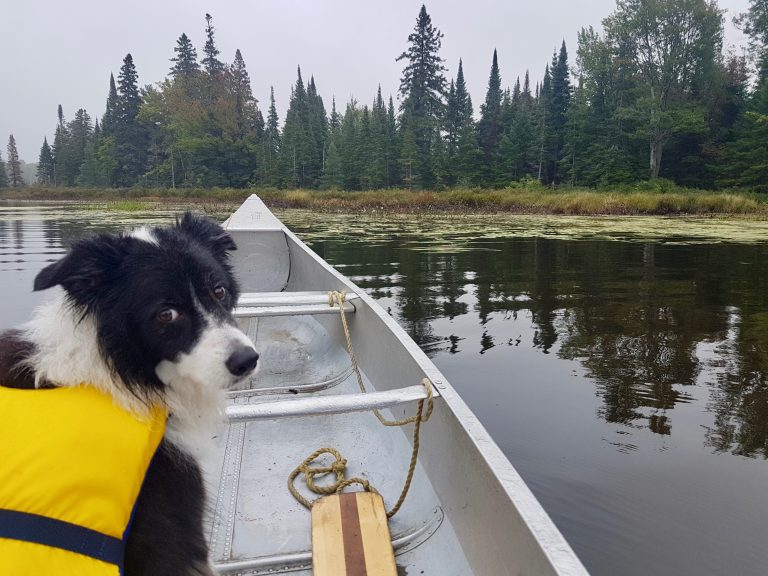The sizzle of summer is just around the corner, and that’s got us thinking of one thing… Camping!
However, we wouldn’t dare to go camping without our furry, four-legged companion, Shilo. She absolutely loves it! – the sites, the sounds, the smells and even the canoe rides.
Dog owners often ask, “how do I camp with a dog?”. Well, below are 9 quick tips for camping with your dog to ensure you and Fido have a great time in the great outdoors.

1. Check for Dog-Friendly Campgrounds and Parks
When planning a camping trip, be sure to check whether the park or campground you’re planning to visit is dog-friendly. Most park and campground websites usually list if dogs are permitted in their park rules or FAQ section.
Be sure to find out both on and off-leash areas and consult campsite policies for trails and water area etiquette.
Pro tip: If you’re trekking in the backcountry, be sure check if there will be any harmful plants and wildlife in the area (e.g. snakes, coyotes, bears, poison ivy, etc.) that may be of concern to you and your dog.

2. Schedule a Veterinarian Appointment Before Leaving
As exhilarating (or awful) as it may be, it’s always good practice for your dog to visit the veterinarian before traveling, and especially before camping.
Your vet can ensure your dog is in tip-top shape and ready for the rigours (or the relaxation) of a camping trip.
Also, be sure to keep your dog fully vaccinated! Mosquitos and infected wildlife can carry diseases such as heart worm and rabies. Plus, some parks are prone to deer ticks and fleas, so be sure to speak with your vet about the area you will be visiting.

3. Practice Obedience Commands at Home
In any new environment, your dog will be prone to distractions and potentially wander off. Before leaving home, take the time to reinforce some basic commands: Sit, stay, wait, leave it, come.
These commands will be so useful while camping, especially if you are staying in a busy park with other campers and while in the backcountry with more instances of ground dwelling animals.

4. Attach a Contact Info Tag
Just in case your dog wanders into someone else’s campsite or, heaven forbid, gets lost in the wood, it’s a good idea to make sure there’s a means for someone to contact you if they find your dog.
An engraved contact info tag with your dog’s name, your name and phone number(s) will help you reunite your dog if she gets separated from you.
Pro tip: Check your dogs existing tags regularly as they do tend to wear down over time… We’ve found lost dogs in the past and in one case the tag was almost unreadable!

5. Familiarize Your Dog with Your Gear
If it’s your first time camping with your dog, set up your tent at home and let your dog familiarize him/herself with it.
Get them to walk in and out of your tent, zip up the doors with you both inside and outside, and rattle the structure a bit to simulate a windy day. So, when it comes to camp day, your dog won’t be anxious and will happily snuggle up and sleep next to you in her new home away from home.

6. Pack Enough Food and Water
Certain types of camping require us to be more active, so it’s always wise to pack slightly more food than normal to feed your dogs already voracious appetite. Your dog will be burning more calories hiking, swimming and keeping guard against a squirrel invasion. To keep their energy level high, consider packing 10-15% more food than usual.
Remember, store dog food with the same considerations as your own. Place dog food in a bear box or food barrel. Do not leave kibbles or scraps at your campsite as they can attract unwanted visitors during the night.
Always keep a water bowl out to help your dog stay hydrated, especially on hot and humid days. This prevents your dog from consuming contaminated or stagnant water around the campsite.

7. Pack the Right Dog Gear
Not only do you need to bring the right camping gear for yourself, you also need to bring the right gear for your dog.
Here’s a short list of dog gear you’ll need to consider, depending on the type of camping your planning on doing:
- Collapsible food and water bowls
- Short leash for wooded area
- Tether and ground stake for your campsite
- Quick-dry towel for keeping the wet dog smell to a minimum
- Biodegradable poop bags
- Collar night light
- Collar bell for off-leash hiking and to alert other animals of your presence
- Sleeping pad and blanket
- Pop-up crate (if trained)
- Dog sweater for cooler nights / winter camping – Check out Chilly Dogs for durable dog coats that are sure to fit any size!
- Life jacket with handle if you’ll be on or near water – this is mandatory if canoeing with your dog

8. Carry Canine First-Aid Supplies and Medication
Just like you, your dog is susceptible to injury while camping. Cuts and insect bites will need to be treated to prevent infection and reduce swelling.
Consider purchasing a dog-friendly first-aid kit or add dog-related supplies to your personal first-aid kit.
Remember to check for ticks on paws and legs while camping, especially if you’re near long grass and wooded areas. Also, as a precaution, review tick removal techniques online before you leave, just in case you need to remove one of those little buggers yourself.
Finally, if your dog is on any medication, don’t forget to bring it with you!
Pro tip: Driving to campgrounds can be stressful, so if your dog starts to feel nauseous consider administering Gravol. It’s dog-friendly and will help relieve car-sickness!

9. Bring a Favourite Toy
Just like kids who are comforted by a blanket or a stuffed toy from home while on vacation, so too are dogs. That’s why bringing a favorite toy can help keep your dog focused during the day and relaxed at night.
We usually bring a bright coloured tennis ball for fetch and Shilo’s favourite stuffed animal, the lamb chops play along plush, for night-time cuddling in the tent.
Camping with your dog can be an uplifting and bonding experience. Sharing mother nature with your furry friend can lead to endless adventures. For you and your dog’s well-being, plan and prepare beforehand to make the most out of your camping trip!
How do you and your dog prepare for camping? Let us know in the comments below!
https://www.instagram.com/p/BodITUjBx8d/?utm_source=ig_web_button_share_sheet

